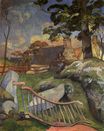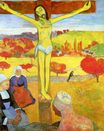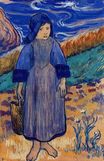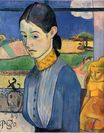Paul Gauguin - Yellow Christ 1889
 |
 |
 |
 |
 |
 |
 |

Yellow Christ 1889
92x73cm oil/canvas
Albright-Knox Art Gallery, Buffalo, NY, USA
The image is only being used for informational and educational purposes
<< Previous G a l l e r y Next >>
From Albright-Knox Art Gallery, Buffalo:
In the summer of 1886, Paul Gauguin visited the small village of Pont-Aven in Brittany, where he became fascinated with the long history of peasant life and its traditional costumes, customs, and rituals. He painted numerous scenes of peasant life and the countryside, including The Yellow Christ.
The traditionally costumed women could be having a vision, or just praying next to one of the many roadside chapels in rural France. The figure of Christ is based on a crucifix in a local chapel near Pont-Aven, and Gauguin said he chose the color yellow to convey how he felt about the isolated life of the peasants in Brittany. The yellow also links Christ to the landscape, which relates to the tradition and spirituality of Breton life through the centuries. The season represented is fall—harvest time—and the agricultural cycle was seen as a parallel to the religious cycle of Christian life—birth, life, death, and rebirth in Heaven. It also followed more specifically the Passion Cycle of Christ: fall, when crops are harvested, would be equivalent to the crucifixion; then follows winter, when nothing grows, parallel to Christ’s three days in the tomb; and finally springtime arrives, when everything comes back to life, a celebration like Christ’s resurrection.